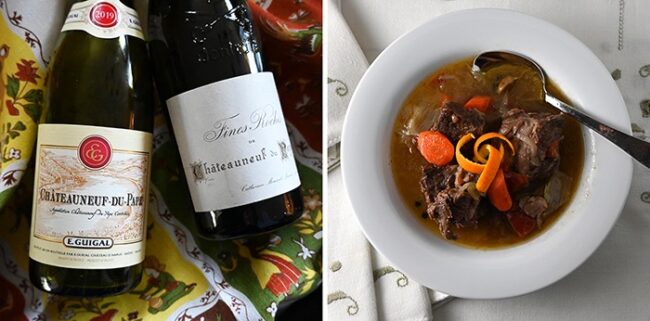Provençal Pairings: Wine with Food White and Red, Daube and Wine
by David Scott Allen
Winery: E. Guigal
Cuvée: Châteauneuf-du-Pape Blanc
Appellation: Châteauneuf-du-Pape
Type: White
Vintage: 2019
Grape Varieties: 45% Grenache blanc, 25% Roussanne, 15% Clairette, 10% Bourboulenc, 3% Piquepoul, 2% Picardin
Alcohol: 14.5%
Average Retail Price: $68.00
Winery: Château Fines Roches
Cuvée: Fines Roches
Appellation: Châteauneuf-du-Pape
Type: Red
Vintage: 2015
Grape Varieties: Mourvedre, Syrah, Grenache
Alcohol: 13.5%
Average Retail Price: €30.00
I’ve had a couple of firsts recently — the Swiss Fondue last month (see Savoie Faire) and now my first Daube. I knew daubes were generally made with red wine, but Susan introduced me to Patricia Wells’ recipe for a White Daube. Wells suggests that making it with a white Châteauneuf-du-Pape is traditional, but I find that a bit extravagant. Happily, she offered the suggestion to use “any drinkable white without too much oak.” That worked much better for me. However, when pairing with the daube, I did serve both a white and red Châteauneuf-du-Pape and thoroughly enjoyed both. For my version of Wells’ recipe, visit Cocoa & Lavender. For more about the two wines, read on.
If someone were to ask me what my favorite wine is, I would have to say it’s a Châteauneuf-du-Pape Blanc. While I could not bring myself to make the daube with this wine, I knew I had to try pairing it with this wine. I chose an E. Guigal 2019 vintage, and it was at its prime for drinking. The color of golden straw, it has aromas of candied melon and marshmallow, and a complex palate that offers apple compote, orange-fleshed melon, apricot, dried mango, jasmine, and a touch of pineapple with a nice long, citrusy finish. It paired beautifully with the white daube, highlighting the rich beef, vegetable, and mushroom broth.
On the other hand, we had a red Châteauneuf-du-Pape to compare. This was a 2015 CdP by Château Fines Roches. A deep purple-red, it has vibrant, earthy aromas of blueberry, purple plum, and rose. The earthiness continues on the palate with more dark fruit, blackberry, and leather. It is incredibly well-balanced and, as you might guess, it also paired stunningly with the daube, even with its white wine base.
Did I have favorite of the two? That is like asking me to pick my favorite child. They were both beautiful wines that paired perfectly with the meaty daube. And I actually liked having them both beyond wanting to test the pairings. In the future, perhaps my first helping of the daube will be accompanied by the white, and I might have the red with my second helping. Talk about wine diplomacy!
If Châteauneuf-du-Pape isn’t in your budget, try this with a white or red Côtes du Rhône — of course a Vacqueyras or Gigondas would be lovely, too.


Leave a comment